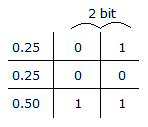Test: Communication Systems - 6 - Electronics and Communication Engineering (ECE) MCQ
25 Questions MCQ Test - Test: Communication Systems - 6
In a two tone AM system the two modulating frequencies are 2000 p and 4000 p rad/sec. If carrier frequency is 2p x 106 rad/sec the frequencies of upper sidebands are
| 1 Crore+ students have signed up on EduRev. Have you? Download the App |
For a system to be designated as hi-fi, the signal to noise ratio should be at least
Dolby system of noise reduction divides the total audio spectrum into
In a system an input resistance of 20 kΩ causes a noise voltage of 15μV. If two such input resistances each of 20 kΩ are used in parallel, the total noise voltage will be about
In the television system in India, the odd and even fields are scanned
Consider the following
- A signal f(t) and its Hilbert transform fh(t) have the same energy density spectrum
- A signal f(t) and its Hilbert transform, fh(t) have the same auto correlation function
- A signal f(t) and its Hilbert transform are mutually orthogonal
A TV receiver has a width of 60 cm. The aspect ratio is 4/3. The required EHT supply is about
A narrow band noise n(t) has symmetrical spectrum and has power density spectrum 0.2 x 10-6. The power density of quadrature component is
The reactance of coupling capacitors, for DC quantities, is
An AM wave is given by s(t)AM = 20 (1 + 0.5 cos 103t + 0.3 cos 104 t cos 106 t) the modulation index of the envelope is
The modulating frequency in frequency modulation is increased from 10 kHz to 30 kHz. The bandwidth is increased by
A sinusoidal signal with peak to peak amplitude of 1.536 volt is quantized into 128 levels using a mid-rise uniform quantizer. The quantization noise power is
An FM wave is made to pass through a frequency tripler. If original modulation index is mf, the output of tripler has a modulation index equal to
A signal m(t) with bandwidth 500 Hz is first multiplied by a signal g(t) where  . The resulting signal is then passes through an ideal low pass filter with bandwidth 1 kHz the output of the low pass filter would be
. The resulting signal is then passes through an ideal low pass filter with bandwidth 1 kHz the output of the low pass filter would be
If γ = (S0/N0)/(Si/Nm) where S0 and S1 are signal power output and signal power input and N0 and Nm are noise power output and noise power input, the value of γ for SSB-SC and DSB-SC amplitude modulated system respectively are
Consider the draw backs
- Slope overload
- Serration noise
- Granular noise
It is required to increase the maximum range of a radar by a factor of two. The peak power transmitted in the radar system has to be increased by a factor of
A source generates three symbols with probabilities 0.25, 0.25, 0.50 at a rate of 3000 symbols per second. Assuming independent generation of symbols, the most efficient source encoder would have average bit rate is as
Armstrong F.M. transmitter performs frequency multiplication in stages


 .
. ratio at least equal to 50 dB.
ratio at least equal to 50 dB. = 10.6 μV.
= 10.6 μV. = 45 cm.
= 45 cm.  .
. .
. .
. B.W.
B.W. 
 .
.
 m(t).
m(t).
 Number of bits/sec
Number of bits/sec 45000 bits/sec.
45000 bits/sec.
















